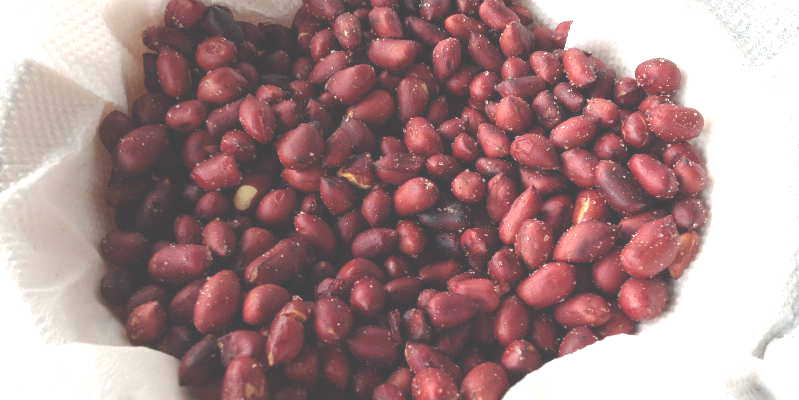Health
Your favourite dish could be the source of cancer

Ground nuts are some of the cereals most affected by aflatoxins. Research shows most markets have g-nuts infested with aflatoxins. Internet photo
It is not chips or rolex that I am writing about. It is rather maize flour, your favourite ground nut paste and off-the-shelf baby foods that are increasingly conquering our food menus in Uganda.
The danger is not the types of food themselves, but rather the chemical susbtance called Aflatoxins that is produced when food is colonised by fungi. According to Scientists, in its early stages of contamination, aflatoxins is invisible and tends to be eaten in foods – especially that which is milled such as maize, sorghum, millet, rice, ground-nuts.
The sad reality of the matter is that the toxin-laced food arising from the fungi contamination, is so prevalent (up to about 45%) of all grains produced in Uganda. Due to high levels of prevalence, aflatoxin contamination of food in Uganda has had far-reaching adverse health and economic implications. This has happened usually without unsuspecting consumers noticing the danger, but also without sufficient warning from relevant authorities about hte danger that lurks in the grains, the milled paste, the processed and packed baby food. Livestock in Uganda, especially chickens, are considered to be at a proportionately higher risk because of the feeding habits of farmers that regard ‘waste food’ as fit for animals, yet most of the food is usually contaminated.
Scientists say that aflatoxins cause cancer of the liver (hepatocellular carcinoma) or HCC, Jaundice, compromise the immune system of a person or animal and also interfere with the absorption of essential nutrients such as proteins and micronutrients such as zinc resulting into stunted growth.
Aflatoxins can be consumed directly, through eating contaminated maize/flour, porridge, eshabwe/yoghurt and peanut paste, or indirectly by eating chicken meat or drinking milk of animals that fed on feed that was contaminated with aflatoxins. More worrisome perhaps, is that aflatoxins remain stable and dangerous even under regular heating conditions of up to 140 degrees Celsius.
Whereas the greatest danger lurks in eating contaminated grain and processed foods such as baby food, eating broiler chickens that may be fed on contaminated chicken feed, carries a serious risk of metabolised residues of the toxic substance alternatively called aflatoxin M1.
Research shows that aflatoxin contamination of food in Uganda is at alarming levels. And perhaps this is not by accident if you consider that moulds are found on inadequately dried food and feed as the case is with most grains. They also thrive well in hot and humid environments such as as ours.
As David Okello, a researcher with the National Agricultural Research Organisation (NARO) discovered along with colleagues in a 2010 study titled: “Management of Aflatoxins in Groundnuts,” majority of farmers, traders and consumers in Uganda are not aware of the aflatoxin contamination of food and feed and their implications on commerce, human and livestock health.
The researchers cited a previous study that found that all forms of ground nuts that were obtained from retailers in three of Kampala’s busiest markets i.e St. Balikuddembe, Nakawa and Kalerwe ‘had levels of aflatoxin significantly higher than the recommended 20 ppb by the World Health organisation WHO as well as the US Food and Drug Administration (FDA).’
The severity of aflatoxin contamination in food stuffs is demonstrated not only by its impact in causing cancer and halting growth, but also in short-term liver failure that can cause death in less than 24 hours. In 2004, for example, more than 200 people died in Kenya with more children dying in later months, as a result of consuming maize contaminated with aflatoxins.
Given the adverse health and commercial effects of aflatoxins, a number of countries, including in Africa, have regulations in place to monitor levels of aflatoxin infestation.
Uganda is yet to put in place an industry-wide system that monitors and regulates aflatoxin accumulation in grain, let alone a mechanism to sensitize both farmers and consumers on the problem. The Uganda National Bureau of Standards (UNBS) keeps a 10 ppb (parts per billion) standard as the allowable level of aflatoxin contamination in grain but the measure is hardly enforced not only in local produce markets and supermarkets, but also in cross-border markets where large-scale grain trade takes place.
Experts are warning however that the lack of awareness about aflatoxins is having far reaching health effects besides complicating the challenge of liver cancer.
According to data from the Kampala Cancer Registry which was analysed by experts between 1960 to 1980 and 1991 to 2005, hepatocellular carcinoma (HCC) accounted for the highest percentage (79%) of primary causes of liver cancer in Uganda.
The International Agency for Research on Cancer (IARC) ranks aflatoxin as a Class one carcinogen or one of the most potent causes of cancers in the world.
Uganda’s apparent laxity in monitoring and controlling levels of aflatoxins may however emerge as a serious threat to trade not only with the more strict European Union but also within the region where awareness of the challenge is said to be growing.
Only recently, the European Commission threatened a ban export of sweet pepper and other vegetables because of using toxic herbicides. This resulted into the ministry imposing a ban on exports of pepper to the European market as a mechanism to sort out quality issues with farmers.
Prevention methods
Researchers argue that the most effective way to prevent aflatoxins from developing in food and feeds is by ensuring that it is properly dried and kept in an environment that locks the food away from insects.
Experts also argue for the establishment of a mechanism for monitoring susceptible produce from farm level through buying points to retail markets as well as good manufacturing practices during the processing and distribution of various products.
Useful innovation
On a positive note, researchers from the Uganda Industrial Research Institute (UIRI) last year (2014) developed a Portable Electrochemical Biosensor (Peb) that is considered very effective in detecting aflatoxins in a given product.
In October last year, innovators of the biosensor won the United Nations Young Scientist Innovators award.
Okello and colleagues also reported that new methods now exist for detoxifying aflatoxins once consumed by animals.
They wrote thus: “The utilisation of specially processed phyllosilicate/bentonite clays especially hydrated sodium calcium aluminosilicate (HSCAS) that selectively bind and inactivate aflatoxins in the gastrointestinal tract of farm animals such as chickens, turkey, lambs, goats and pigs has been the most successful chemoprotection.”
Comments


























